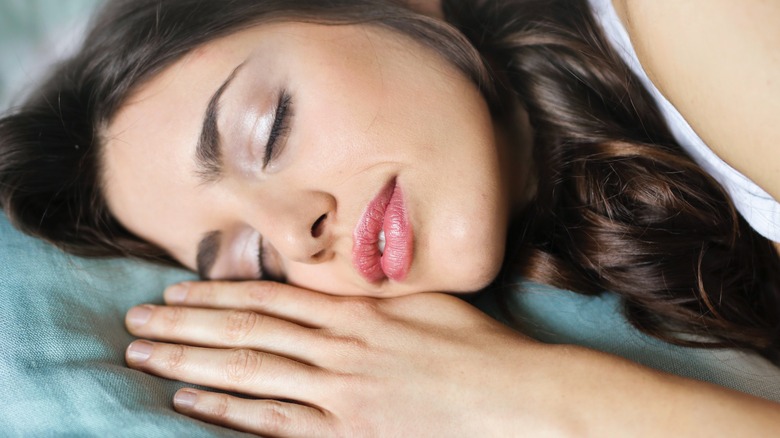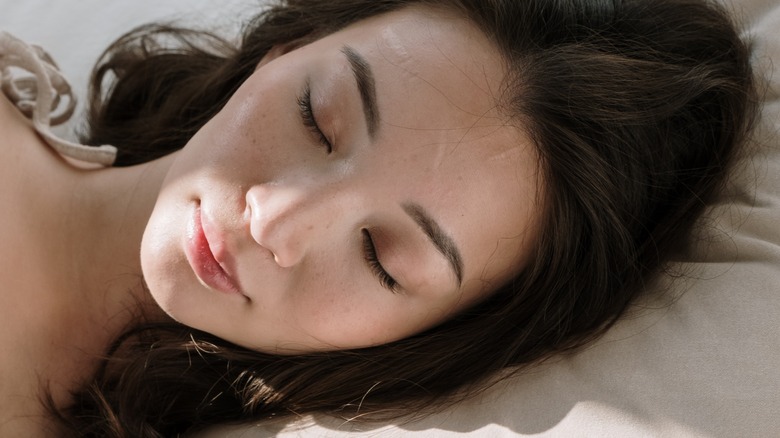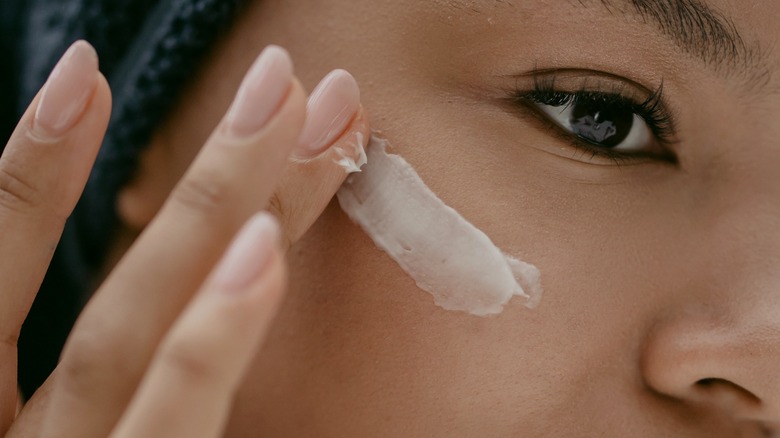How To Make Sure Your Overnight Skincare Stays On Your Face And Not Your Bedding
Your skin's restoration process normally begins at night. When you rest, your skin finally has the time to undo all of the daytime damage from environmental pollutants and rejuvenate. This allows it to better absorb skincare nutrients and achieve desirable outcomes, per L'Oréal Paris. Therefore, what you put on your skin before resigning to your beauty rest plays a critical role in the health of your skin. An ideal nighttime skincare routine — aside from cleansing and toning — usually includes spot treatment, moisturizing, and the application of eye cream. Many people can't call it a night without slugging, which is an act of religiously daubing one's face with petroleum jelly to lock in the moisture, according to dermatologist Dr. Adarsh Vijay Mudgil (via Cosmopolitan).
Although feeding your skin with nourishing nutrients is essential, going to bed with a face loaded with skincare products isn't always a pleasant experience. It's inconvenient to stick to all the steps every night, and the overnight products easily rub off on the bedding, leaving unsightly stains. Looking at a slimy, tainted pillowcase can make you wonder if a large amount of your skincare formula has gone to waste while you're sleeping. To make sure your overnight skincare ingredients stay on your face and not your sheets, we've included some hacks to help you roll under your blanket with greater peace of mind.
Get a pillowcase protector or go with satin
A pillow protector can be a game changer in your evening skincare routine, accessories expert Amelia Jerden tells Sleepolosis. Pillow protectors, as the name implies, are specifically designed to shield your pillows from dirt, dust mites, and accidental spills. They are similar to pillowcases in their design, except that they boast thicker material for better protection and an extra layer of plushness. By creating an extra barrier, a pillow protector prevents liquids or creams from finding their way onto your pillow to keep it clean. You can move all you want during your sleep, and your skincare products won't smear on your pillowcase.
If the idea of putting an extra sheet on your pillow seems too redundant to you, consider changing your pillowcases to satin. According to Satin Serenity, satin is non-absorbent and therefore unable to absorb your applied skincare products. Unlike the more abrasive cotton alternative, a satin pillowcase is soft and cool to the touch — you can glide your face against it without friction or the formation of creases on your face. Satin doesn't pull at your skin and can easily be washed with the rest of your laundry.
Use a lightweight product and sleep on your back
Another way to make sure your bedding doesn't absorb your overnight skincare products is to opt for lightweight skincare products that are absorbed into your skin faster. If you go to bed with greasy residue on your face, your bedding will undoubtedly eat it up. When it comes to fast-absorbing products, cosmetic chemist Krupa Koestline tells Well+Good that oil-soluble products and emulsions, which are lighter versions of moisturizers, can penetrate the skin faster than water-based elements. If you're a fan of oil-free products, look out for fermented properties — the fermentation process divides molecules into smaller sizes to allow for more effective, rapid penetration. If your nighttime products soak into your face before you snooze, you'll leave nothing else for your bedding to absorb.
If none of the aforementioned tips are applicable to you, consider changing your sleeping position as a last resort. According to Skincare.com, sleeping on your back throughout the night instead of on your side or your stomach is the most simple way to make sure your facial products don't spread to your pillowcase. Sleeping on your back also prevents the formation of wrinkles, keeps your spine aligned, and staves off heartburn.


